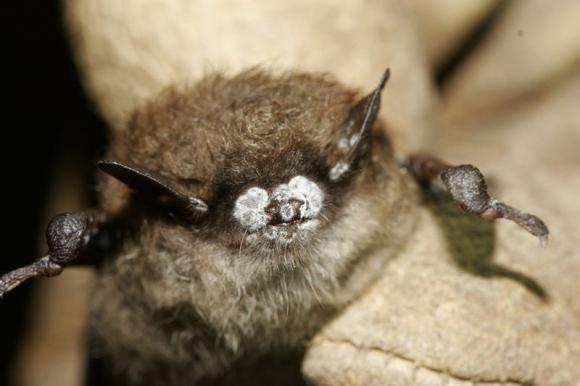PROVIDENCE, R.I. [Brown University] — More than 6 million bats have died in North America in less than a decade because of a lethal epidemic of white nose syndrome, caused by the fungus Pseudogymnoascus destructans. A new discovery, however, may help turn the tide: Scientists have found a particular enzyme secreted by the fungus that may cause much of the damage to collagen in the bats.
The team from Brown University and the University of California–San Francisco call the protein, a protease enzyme, “Destructin-1.”
“This study suggests that proteases may help in infection and so addition of protease inhibitors could block degradation and invasion of bat tissues by the fungus,” said Richard Bennett, associate professor of biology at Brown and a co-corresponding author of the study in the Proceedings of the National Academy of Sciences.
After they discovered Destructin-1 and characterized its nature, the scientists showed in the lab that they could use a protease inhibitor to stymie it. When they added chymostatin to a preparation of collagen being degraded by P. destructans enzymes they saw a 77-percent reduction in collagen damage after 54 hours compared to controls that did not get chymostatin.
To identify Destructin-1, the team started by examining all the dozens of proteins secreted by the fungus. They put them through a battery of sophisticated assays to determine which proteins are present in the “secretome” and which were proteases. In white nose syndrome, the fungus penetrates the bodies of hibernating bats who have reduced immune function. The resulting injuries awaken the bats, who then use up their fat reserves too soon and starve to death.
Now that the researchers have characterized Destructin-1 in detail and showed that it can be inhibited, they still have more work to do. They want to try to inhibit the fungus in real bats, rather than just in lab preparations.
Bennett said they also need to answer why chymostatin could only reduce collagen damage by 77 percent, rather than completely.
“On the surface it suggests there are other activities in the secretome that can degrade collagen,” he said. “There is more to discover.”
The paper’s lead authors are Anthony O’Donoghue and Giselle Knudsen of UCSF. The paper’s other authors are Chapman Beekman and Jenna Perry of Brown, and Alexander Johnson, Joseph DeRisi, and Charles Craik of UCSF.
The Sandler Foundation, the Burroughs Wellcome Fund, and the NIH funded the study.

